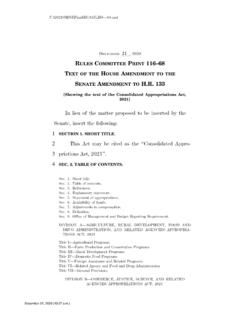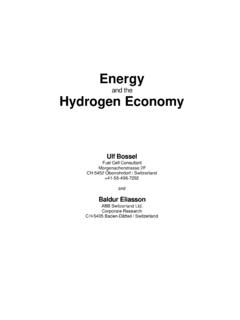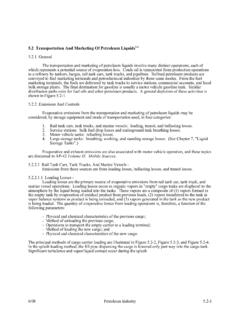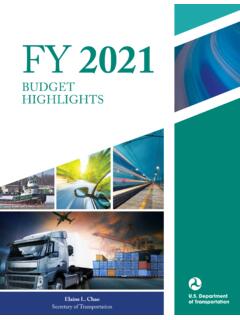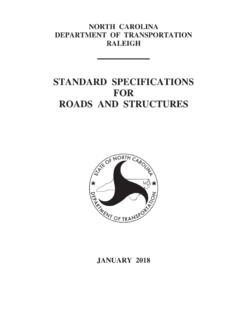Transcription of NATURAL GAS INFRASTRUCTURE - Energy
1 Appendix B: NATURAL Gas Page | 1 NATURAL GAS INFRASTRUCTURE Highlights Increasing Supply. The NATURAL gas industry has undergone change of unprecedented magnitude and pace. NATURAL gas production increased 33 percent between 2005 and 2013. Production has shifted from traditional regions, such as the Gulf of Mexico, toward onshore shale gas regions. Most important for INFRASTRUCTURE has been the rapid growth of production in the Marcellus and Utica Basins, a trend that is expected to continue out to 2030 (the time horizon under consideration for the Quadrennial Energy Review).
2 Production has shifted to liquids-rich plays that also produce NATURAL gas liquids (NGL) and crude oil. Increasing Demand. Long-term gas demand affects the pace of midstream INFRASTRUCTURE investment, as new pipelines require shippers to sign contracts to finance the expansion. The increased supply of NATURAL gas at historically low prices has significantly changed the economics and use of NATURAL gas for electric power and industrial uses. Gas demand for power generation has grown from billion cubic feet per day (Bcf/d) in 2005 to Bcf/d in 2013. Further drivers of demand growth include significant new investment in industrial facilities, low capital costs, and proposed regulations that could encourage fuel switching in some regions.
3 New INFRASTRUCTURE . Existing system flexibility and latent pipeline network capacity is likely to mitigate the magnitude of future investment required. Recent investment trends and projects in development indicate that, in most regions, existing policy and investment mechanisms are addressing constraints as they emerge. Analysis suggests that demand growth from liquefied NATURAL gas exports is unlikely to strain the system in ways that cannot be resolved by existing mechanisms. Gas-Electric Interdependencies. As gas use for power generation increases, the interdependency between the gas and electricity sectors can create regional reliability challenges.
4 Coordination between the two industries, including, for example, alignment of gas and electricity bidding and scheduling days, remains an issue that requires further attention. In some regions, gas-fired power generators lack incentives for procuring gas in time frames and at volumes that would provide market signals for gas industry INFRASTRUCTURE investment. Maintaining and improving the flexibility of the NATURAL gas system through high-deliverability gas storage or gas-electricity system flexibility solutions ( , electric demand response; adding NATURAL gas pipeline capacity, dual-fuel capability, and end-use Energy efficiency; and adding electric transmission capacity) can assure not only the reliability and resilience of NATURAL gas delivery, but of the electricity system.
5 Processing. Wet gas production requires more processing capacity for NATURAL gas and more transportation capacity for NGL. In the Bakken, extraction of associated gas has been driven primarily by demand for tight oil, resulting in significant flaring when takeaway capacity and local use of associated NATURAL gas and NGL is outpaced by production (see Appendix A (Liquid Fuels) for discussion of NGL). The State of North Dakota has implemented new regulations to reduce gas flaring, which will likely lead to the development of additional processing and gathering INFRASTRUCTURE in the state.
6 National processing capacity is currently 83 Bcf/d and expected to increase to 95 Bcf/d by the end of 2017. This projected increase is expected to alleviate existing processing constraints for most regions of the United States, particularly in the Marcellus. Climate and Environmental Implications. The growth in gas-fired power generation can reduce carbon dioxide and criteria pollutant emissions from power generation. Methane emissions contributed to roughly 10 percent of gross greenhouse gas emissions (on a carbon dioxide-equivalent basis) from anthropogenic Appendix B: NATURAL Gas Page | 2 sources; nearly one-quarter of which (or percent of total carbon dioxide-equivalent emissions) were emitted by NATURAL gas More than two-thirds of those NATURAL gas-related emissions of methane emissions from NATURAL gas systems are from NATURAL gas transmission, storage, processing, and distribution.
7 Public Safety. NATURAL gas distribution pipelines are responsible for the majority of serious gas pipeline safety incidents. These incidents tend to occur in densely populated areas. Excavation damage is the leading cause of serious incidents along NATURAL gas pipelines; although, significant and preventable contributors also include equipment failure, incorrect operation, and pipeline NATURAL gas distributors, who largely serve residential and commercial loads, face a need to refurbish or replace aging and leak-prone pipes, or make other system Though the total costs of replacing these pipes is estimated to be many billions of dollars, replacement brings with it meaningful risk reduction and emissions Government Role.
8 There are critical government roles across Energy systems to help protect public and private interests with respect to reliability, safety, and environmental performance. Various government agencies work at the Federal, state, and local levels to help enable these goals, including through facility permitting, safety inspections, and market oversight all of which is essential to prudent system development and operations. a Environmental Protection Agency. Greenhouse Gas Inventory. Table ES-2. 2014.
9 Accessed April 1, 2015. b Department of transportation , pipeline and Hazardous Materials Safety Administration. pipeline Incident 20 Year Trends. 2015. Accessed February 25, 2015. c Department of transportation , pipeline and Hazardous Materials Safety Administration. "2013 Gas Distribution Annual, from Form PHMSA F (rev 1-2011)." 2014. d American Gas Association. "Managing the Reduction of the Nation s Cast Iron Inventory." 2013. Appendix B: NATURAL Gas Page | 3 Introduction This appendix focuses on the transmission, storage, and distribution (TS&D) systems for NATURAL gas and begins with a description of the changing landscape of NATURAL gas in the United States.
10 This includes analysis of recent and projected increases in domestic gas production and the potential magnitude and unique attributes of sources of demand. From there, the INFRASTRUCTURE implications of changing supply and demand are analyzed and discussed by midstream project type: NATURAL gas processing, transmission, storage, distribution, and export INFRASTRUCTURE . Following this system characterization are analyses and discussion of major attributes of the NATURAL gas system as a whole, including NATURAL gas and electricity interdependence, system resilience, pipeline safety, and emissions.










